London Transport Museum
The London Transport Museum (often abbreviated as the LTM) is a transport museum based in Covent Garden, London. The museum mainly hosts exhibits related to the heritage of London's transport, as well as conserving and explaining the history of it. The majority of the museum's exhibits originated in the collections of London Transport, but, since the creation of Transport for London (TfL) in 2000, the remit of the museum has expanded to cover all aspects of transportation in the city.
 | |
.jpg) | |
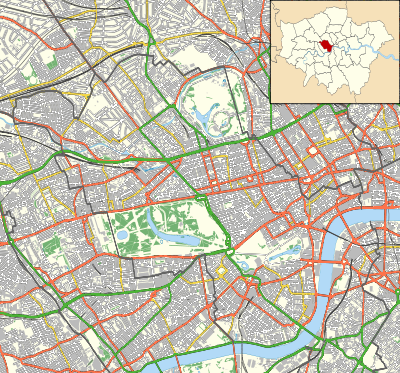 Location within City of Westminster | |
| Established | 1980 |
|---|---|
| Location | Covent Garden London, WC2 |
| Coordinates | 51°30′43″N 0°07′18″W |
| Type | Transport museum |
| Visitors | 353,921 (2018)[1] |
| Public transit access | |
| Website | www.ltmuseum.co.uk |
The museum operates from two sites within London. The main site in Covent Garden uses the name of its parent institution, and is open to the public every day, having reopened in 2007 after a two-year refurbishment. The other site, located in Acton, is known as the London Transport Museum Depot and is principally a storage site of historic artefacts that is open to the public on scheduled visitor days throughout the year.
The museum was briefly renamed London's Transport Museum to reflect its coverage of topics beyond London Transport, but it reverted to its previous name in 2007 to coincide with the reopening of the Covent Garden site.
Museum (Covent Garden)
.jpg)
The museum's main facility is located in a Victorian iron and glass building that had formed part of the Covent Garden vegetable, fruit and flower market. It was designed as a dedicated flower market by William Rogers[2] in 1871 and is located between Russell Street, Tavistock Street, Wellington Street and the east side of the former market square. The market moved out in 1971, and the building was reopened as the London Transport Museum on 28 March 1980.[3] The collection had been located at Syon Park since 1973 and before that had formed part of the British Transport Museum at Clapham.[4]
On 4 September 2005 the museum closed for a major £22 million refurbishment designed by Bryan Avery of Avery Associates Architects[5] to enable the expansion of the display collection to encompass the larger remit of TfL which administers all forms of public transport. Enhanced educational facilities were also required. The museum reopened on 22 November 2007.[6][7]
The entrance to the museum is from the Covent Garden Piazza, amongst the Piazza's many tourist attractions. The museum is within walking distance from both Covent Garden Underground station and Charing Cross railway station.[8]
Depot (Acton)
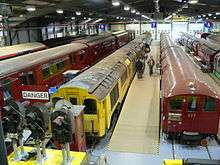
The Museum Depot is located in Acton, west London, and was opened in October 1999. The depot holds the majority of the Museum's collections which are not on display in the main museum in Covent Garden. It is the base for the museum's curators and conservators, and is used for the display of items too large to be accommodated in the main facility.[9]
The depot provides 6,000 square metres of storage space in secure, environmentally controlled conditions and houses over 370,000 items of all types, including many original works of art used for the Museum's collections of posters, signs, models, photographs, engineering drawings and uniforms. The building has both road access and a rail connection to the London Underground network, which allows the storage and display of significant numbers of buses, trams, trolleybuses, rail rolling stock and other vehicles.[9]
The depot is not regularly open to the public, but is fully equipped to receive visitors, with ticket office, shop, a miniature railway,[10] and other visitor facilities. It opens to the public for pre-booked guided tours on several dates each month, and also for special events, including themed open weekends – usually three times per year. It is within easy walking distance of Acton Town Underground station.[9]
Collection
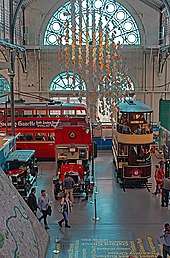
The first parts of the collection were brought together at the beginning of the 20th century by the London General Omnibus Company (LGOC) when it began to preserve buses being retired from service. After the LGOC was taken over by the London Electric Railway (LER), the collection was expanded to include rail vehicles. It continued to expand after the LER became part of the London Passenger Transport Board in the 1930s and as the organisation passed through various successor bodies up to TfL, London's current transport authority.
The collection has had a number of homes. It was housed as part of the Museum of British Transport at a disused tram depot in Clapham High Street (now a supermarket) from 1963 to 1972, and then at Syon Park in Brentford from 1973 to 1977, before being moved to Covent Garden in 1980.[11] Most of the other exhibits moved to York on formation of the National Railway Museum in 1975.
The Covent Garden building has on display many examples of buses, trams, trolleybuses and rail vehicles from 19th and 20th centuries as well as artefacts and exhibits related to the operation and marketing of passenger services and the impact that the developing transport network has had on the city and its population. The first underground electric train, from 1890, can be seen here.[12]
Larger exhibits held at Acton depot include a complete 1938 stock tube train as well as early locomotives from the first sub-surface and first deep-level lines.
London Transport Museum shop
The museum shop sells a wide range of reproduction posters, models, gifts and souvenirs, both at Covent Garden and online.[13] Profits from sales support the museum's activities. In 2012 the museum began offering luggage racks from decommissioned Metropolitan line A Stock trains,[14] which had recently been replaced by new trains, for sale.
Transport links
| London Buses | Covent Garden RV1 Aldwych 4, 11, 15, 23, 26, 76, 172 Aldwych 243, 341 |
| London Underground | Covent Garden Charing Cross |
Gallery
 Various forms of transport
Various forms of transport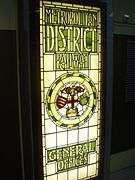 Stained glass door.
Stained glass door. Double-deck Trolleybus.
Double-deck Trolleybus.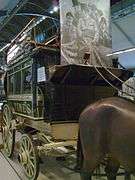 Double-deck horse bus
Double-deck horse bus
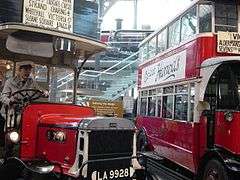 Iconic London buses.
Iconic London buses.
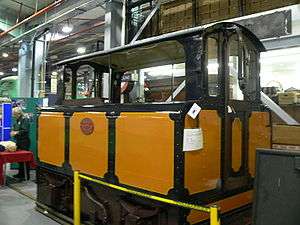 City & South London Railway locomotive number 13
City & South London Railway locomotive number 13- A depiction of a man tunnelling on the City & South London Railway
- Another mannequin at the upper deck of a bus.
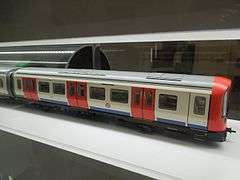 Miniature London tube train
Miniature London tube train Metropolitan Railway steam locomotive number 23
Metropolitan Railway steam locomotive number 23
See also
- List of British heritage and private railways
- List of transport museums (worldwide)
- Island Line (Isle of Wight) – operates reconditioned London underground trains dating from 1938 in regular public service
Other transport museums with items from London Transport:
- London Bus Museum, Weybridge
- Alderney Railway – on the Island of Alderney
- East Anglia Transport Museum – near Lowestoft
- National Railway Museum – York
- National Tramway Museum – Crich
- The Trolleybus Museum at Sandtoft – in North Lincolnshire
Other transport and industrial museums in London:
- Brunel Museum
- Kew Bridge Steam Museum
- London Canal Museum
- London Motorcycle Museum
- Science Museum (London)
- Walthamstow Pump House Museum
Other major transport museums in the UK:
- Black Country Living Museum
- Riverside Museum, Glasgow
- Museum of Transport in Manchester
- Ulster Folk and Transport Museum
- Coventry Transport Museum
References
- "ALVA - Association of Leading Visitor Attractions". www.alva.org.uk. Archived from the original on 23 December 2017. Retrieved 24 August 2019.
- F. H. W. Sheppard (General Editor) (1970). "Covent Garden Market". Survey of London: volume 36: Covent Garden. Institute of Historical Research. Retrieved 10 October 2013.
- Mullins, Sam (9 March 2020). "Shaping London Since 1980". London Transport Museum. Retrieved 29 March 2020.
- "Brief history of the Museum". London Transport Museum. Archived from the original on 11 December 2007. Retrieved 10 December 2007.
- Avery Associates Architects project details Archived 7 July 2011 at the Wayback Machine
- London Transport Museum Project Information Archive.org copy from 19 November 2006
- "Museum re-opens 22 November". London Transport Museum. Archived from the original on 22 October 2007. Retrieved 29 January 2007.
- Buses serve the Strand at stops Southampton Street and Savoy Street. Find us Archived 26 May 2008 at the Wayback Machine – London Transport Museum. Retrieved on 30 May 2008.
- "Acton Depot". London Transport Museum. Archived from the original on 15 December 2007. Retrieved 10 December 2007.
- https://www.ltmuseum.co.uk/visit/museum-depot/miniature-railway
- J.H. Price, "Museum News", Modern Tramway and Light Rail Transit, April 1980.
- http://www.timeout.com/london/museums/london-transport-museum
- "London Transport Museum Online Shop". London Transport Museum. Retrieved 7 March 2012.
- https://londonist.com/2012/03/for-sale-metropolitan-line-luggage-racks
External links
| Wikimedia Commons has media related to London Transport Museum. |